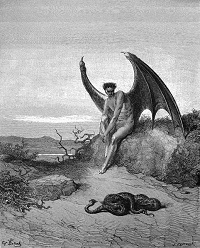
The Fall introduced distortions into the three functions of the soul: Thinking, Feeling, Willing. The centre of gravity fell from the Real I to the I of the personality. The function of meditation is to restore the proper functioning of the functions. In a series of lectures published as Inner Development, Valentin Tomberg describes the effects of meditation:
The general effect of meditation consists in the fact that what is spiritual in a human being descends. That is, the superconsciousness — the higher I — descends into the human personality, and the angel sends down the helping stream of his illumination in the form of “washing of the feet.” Just as Christ bowed down before his disciples and washed their feet, so in every meditation the angel bows down and washes the feet of the meditator.
This is a description of hylomorphism, or vertical causality: the Real I plays its role as the Master of the emotional and physical life. He then describes the triple effect of the Washing of the Feet:
The angel causes the cleansing stream to flow down as far as the individual’s feet. This is the image of the Washing of the Feet. For the washing of the feet consists in the fact that the Luciferic angel is redeemed, the human double is exposed, and the Ahrimanic double is driven out. Hence we could say that the spirit thereby bows down, or inclines downward. By means of meditation, the spirit becomes heavier and the soul becomes inwardly radiant. Insofar as the spirit penetrates the soul, the soul learns to “breathe” the spirit. By “breathing in” the spirit, the soul lights up and extends itself; and by “breathing out” the spirit, it ennobles the body. For what is breathed out by the soul enters into the body.
In the Meditations, Tomberg prefers the term “egregore” to the “double”, or Doppelganger. Ahriman refers to the distortion of the Will function, or the etheric body. In Zoroastrianism, Ahriman resulted from one of Ormuzd’s doubting thoughts. Thus, Ahriman was the second voice heard by Eve in the Garden. The Will becomes a “desire that is perverse or contrary to nature” [Letter XV], which then excites the imagination. Together they constitute the act of the generation of a demon, in this case the Ahrimanic doppelganger in the human.
Purification of the will requires driving out, or expulsion, of the second voice, that of the devil. Purity of heart is to will one thing.
The Lucifer doppelganger refers to the distortion of the Feeling function, or the astral body, by exciting the passions. True transformation requires the liberation from the Luciferic doppelganger. The Hermetist Willi Seiss describes the necessary steps:
The Luciferic doppelganger cannot leave the astral body of man until this astral body is completely shaped by the will of the person in question. First of all, harmonization will be required here, as volitional powers work on the astral body. Then it becomes necessary to do hard work, through which
- willpower,
- emotional life, and
- thought control
are ordered, educated, and shaped.
The effects are deep and deceptive. For example, Lucifer apes God by claiming to be the bearer of wisdom. He uses pride, attachment to opinions, bombast, and passions to obfuscate and confuse. Knowledge of God acts to liberate the astral body (this will be described at the end).
Psychological Complexes
In the Meditations, Tomberg’s deeper understanding moves beyond his earlier work. No longer using terms like Luciferic and Ahrimanic, he instead relates the same phenomena to psychological complexes:
Demons that have not arrived at the stage of objectification, i.e. at that of an existence separate from the psychic life of their parents, have a semi-autonomous existence which is designated in modern psychology by the term “psychological complex”. A psychopathological “complex” is therefore a demon, when it has not come from outside but is engendered by the patient himself. In its state of gestation it is still not born, but it certainly has an almost autonomous life of its own, nourished by the psychic life of its parent. Now, “an autonomous being capable of interfering with the intentions of the ego” and which “possesses a mental life of its own” is nothing other than what we understand by a “demon”. ~ Letter XV, The Devil
In other words, the demon is a creation of the person himself, although he remains unaware of having done so. Carl Jung explains the phenomenology of a complex:
What is not so well known, but far more important theoretically, is that complexes can have us. The existence of complexes throws serious doubt on the naive assumption of the unity of consciousness, which is equated with ‘psyche,’ and on the supremacy of the will. Every constellation of a complex postulates a disturbed state of consciousness. The unity of consciousness is disrupted and the intentions of the will are impeded or made impossible. Even memory is often noticeably affected, as we have seen. The complex must therefore be a psychic factor which, in terms of energy, possesses a value that sometimes exceeds that of our conscious intentions, otherwise such disruptions of the conscious order would not be possible at all. And in fact, an active complex puts us momentarily under a state of duress, of compulsive thinking and acting, for which under certain conditions the only appropriate term would be the judicial concept of diminished responsibility. ~ Structure and Dynamic of the Psyche
At the centre of the complex lies the Will. The Will is not one, because its energy is seized by the different archetypes. This then generates images — false images — which engender emotional reactions that have nothing to do with the real situation. In extreme cases, negative emotions — anxiety, depression, despair, suicidal thoughts, fear, paranoia, anger, hate, mistrust — can overpower the person.
Behaviour then follows, which is often inappropriate and even self-destructive. Anyone who has had to deal with someone with a personality disorder may certainly feel that he is dealing with a demon. Irrationality and severe mood swings make effective communication impossible.
Complexes can also affect the thinking function. This is especially obvious in those obsessed with ideologies. Tomberg writes:
A person who has had the misfortune to fall victim to the spell of a philosophical system (and the spells of sorcerers are mere trifles in comparison to the disastrous effect of the spell of a philosophical system!) can no longer see the world, or people, or historic events, as they are; he sees everything only through the distorting prism of the system by which he is possessed.
These complexes are more insidious because they can affect entire nations.
Every day I encounter some writer or another warning against yoga, or reiki, or some other practice, because they are “demonic”. These writers assume that the demonic is “out there”, so that if we would only stay in our “safe spaces”, we would avoid the demons. The real truth is that the demonic is within, deep within, us. Only the work of intense inner purification can liberate us.
The difficulty is exacerbated because the demons, or complexes, can seem so natural and obvious to the person afflicted. The person then erects a wall for self-protection, only letting a few people in. Of course, those people must not be threatening to the demonic complex, or in contemporary parlance, they are called enablers. All too often, the enablers prefer to keep the afflicted person weak and dependent.
Liberation
Once the afflicted person — and we are all afflicted to a greater or lesser degree — has, through grace, determined to become free, he will look for a solution. Tomberg describes how that might work:
Modern depth psychology has discovered and put into practice the therapeutic principle of bringing unconscious complexes to the light of consciousness. Because — so it affirms — the light of consciousness renders the obsessional complex not only visible but also impotent. This important discovery of modern psychology is in complete accord with the spiritual reality of the “struggle” of the celestial hierarchies against evil. Because this “struggle”, also, amounts to their presence alone, i.e. to bringing evil to the light of day. … Light drives out darkness. This simple truth is the practical key to the problem of how to combat demons. A demon perceived, i.e. on whom the light of consciousness is thrown, is already a demon rendered impotent.
However, psychoanalysis is slow and expensive. Hermetic psychology has developed exercises that are much more effective in bringing the complexes, or unconscious elements, to the light of day. By purifying the heart chakra, this may take effect:
It is the breath of life which dissolves the complex, by way of the heart so that the mistrust, fear or hate, concentrated in the complex is dispersed and the soul is left free of the blinding influence of the psychic complex.
Meditations on God
Prayer and meditation are at the heart of Hermetic psychology. And the greatest meditations are on God. Tomberg recommends scholastic meditation:
Perhaps the quinque viae, the five ways of reasoning, of St. Thomas Aquinas will not necessarily convince you, but you will emerge from meditative work on the five arguments (proposed to prove the existence of God) with a clear head and a calm heart, well-prepared and equipped to seek and find other ways to certainty. It is the occupation with these five ways of reasoning which will render you stronger and calmer, which will elevate you above all the entanglements due to the confused play of complexes which are a mixture of feelings in which personal preferences assert themselves and thoughts which are only a mouthpiece of these preferences. And it is this elevation above psychological complexes which is the salutary effect — even the healing action — of occupation with scholasticism, when one reads in the style of scholastic meditation. ~ Letter XIX, The Sun
It helps to be obsessive — in the good sense of the term — on such meditations, which should fill up your spare time throughout the day. Other meditation topics might be Being, the One, the Good, or the elements of a sound World Conception.

